Calculus &
Linear Algebra II
Chapter 41
41 Surface integrals
By the end of this section, you should be able to answer the following questions:
- What is a surface integral?
- How do you calculate the area of a parametric surface?
- How do you use surface integrals in applications such as calculating the mass of a "surface lamina" and finding the average temperature over a surface.
41.1 Area of a parametric surface
Let $S$ be a smooth parametric surface given by
$\ds \r\left( u, v\right) = x\left( u, v\right)\i + y \left( u, v\right)\j+ z\left( u, v\right)\k$
where we assume for simplicity that the parameter domain is a rectangle in the $uv$-plane.
41.1 Area of a parametric surface
To calculate the area of $S$, we work through the following steps:
- Partition $S$ into small patches.
- Approximate each patch by a parallelogram lying in the tangent plane to the corner of the patch closest to the $u$-$v$ origin.
- Calculate the area $\Delta S$ of each parallelogram and add them to give an approximation to the area of $S$.
- Take the limit as the dimensions of $\Delta S \to 0$ to obtain an exact expression for the area.
41.1 Area of a parametric surface
1. A partition of $S$ into patches will correspond to a partition of $D$ (in the $u$-$v$ plane) into small rectangles.
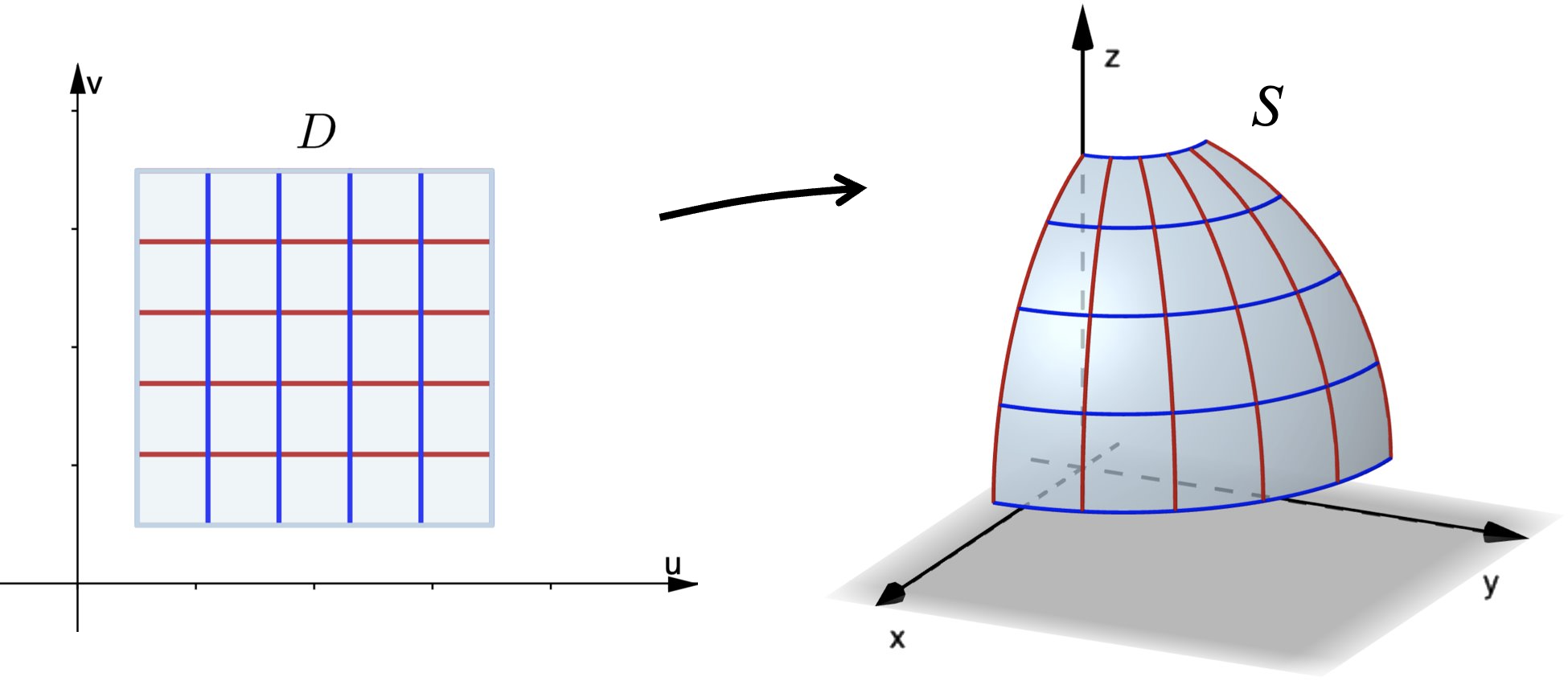
The dimensions of the rectangles in $D$ will be $\Delta u\Delta v$.
41.1 Area of a parametric surface
2. Let one of the edges of a single patch be defined from parameter values $(u, v)$ to $(u+ \Delta u, v)$.
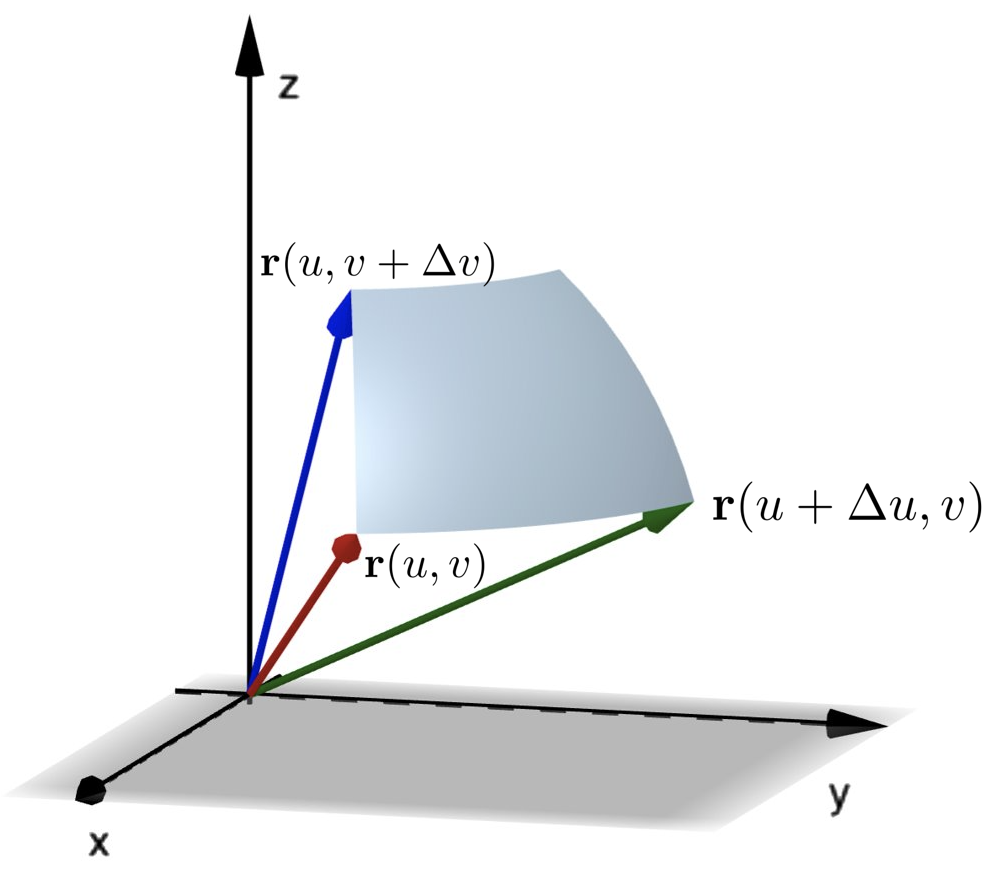
41.1 Area of a parametric surface

|
Using Pythagoras' law in three dimensions, we can approximate the length of this edge as
where in this case we have used $$\Delta x = x(u + \Delta u, v) -x(u, v)$$ etc (i.e., the change is only in $u$). Similarly, for an edge of patch running from parameter values $(u, v)$ to $(u, v + \Delta v)$ the length of that edge will be approximately $||\r_v||\Delta v.$ |
41.1 Area of a parametric surface
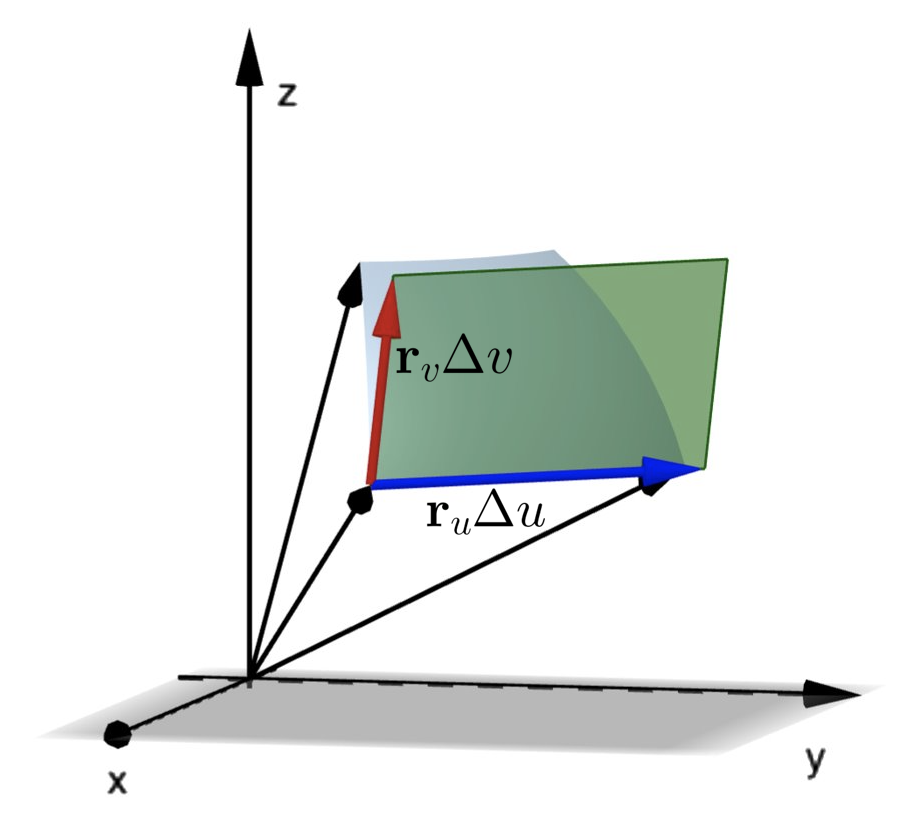
|
At the corner of the patch corresponding to parameter values $(u, v),$ we can define the two vectors $\r_u\Delta u$ and $\r_v\Delta v$ which form two sides of a parallelogram, the side lengths of which coincide with our approximations to the lengths of the edges of the patch. |
41.1 Area of a parametric surface
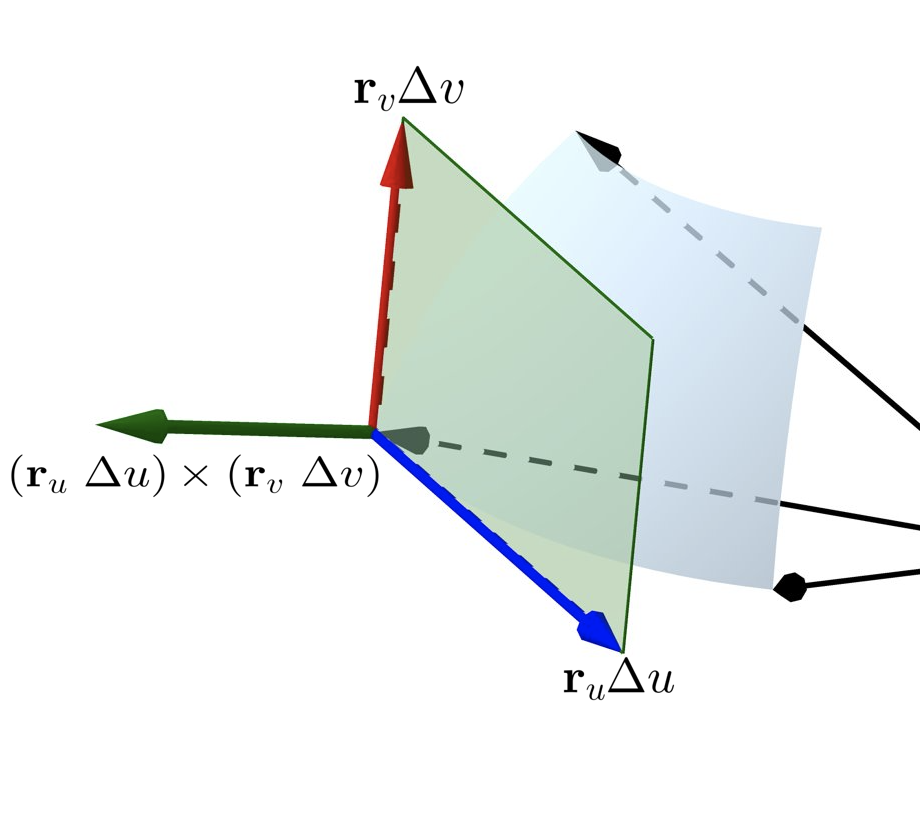
|
The vector $\left(\r_u~\Delta u\right) \times \left(\r_v~\Delta v\right)$ is normal to the surface (and hence the tangent plane) at that point. Its magnitude gives the area of the parallelogram we use to approximate the area of the patch $\Delta S$. We then have \[ \Delta S \approx \norm{\r_u \times \r_v} ~\Delta u ~\Delta v. \] Adding these approximations for each patch in $S$ gives us an approximation to the area of $S$:
|
41.1 Area of a parametric surface
4. Finally taking the limit as $\Delta u, \Delta v \to 0$ we obtain \[ \text{surface area} = \iint_S dS = \iint_D \norm{\r_u \times \r_v} ~du ~dv. \]
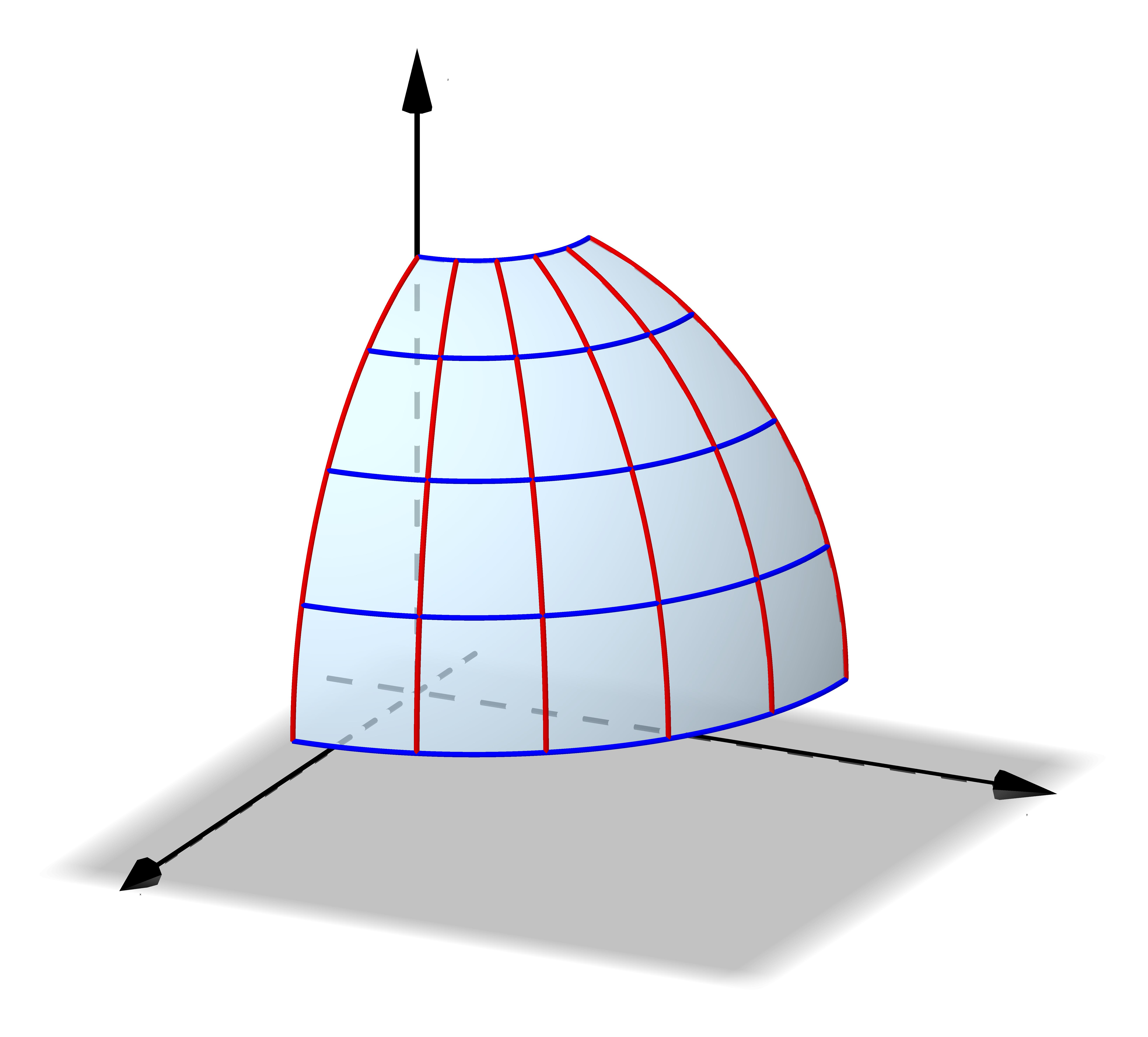
41.1.1 Application: find the surface area of the paraboloid $z=1-x^2-y^2$ for $z\geq 0 $
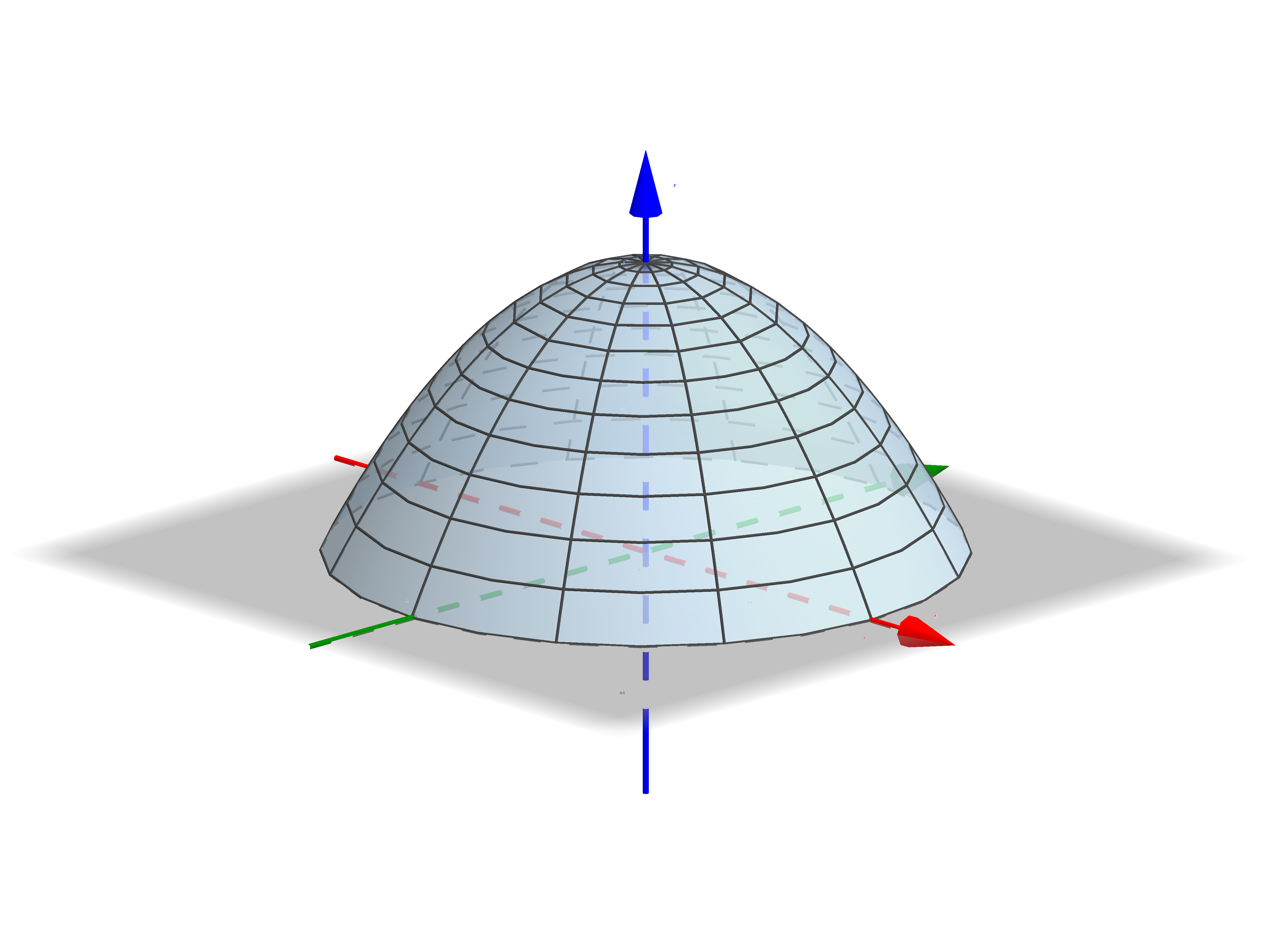
41.1.1 Application: find the surface area of the paraboloid $z=1-x^2-y^2$ for $z\geq 0 $

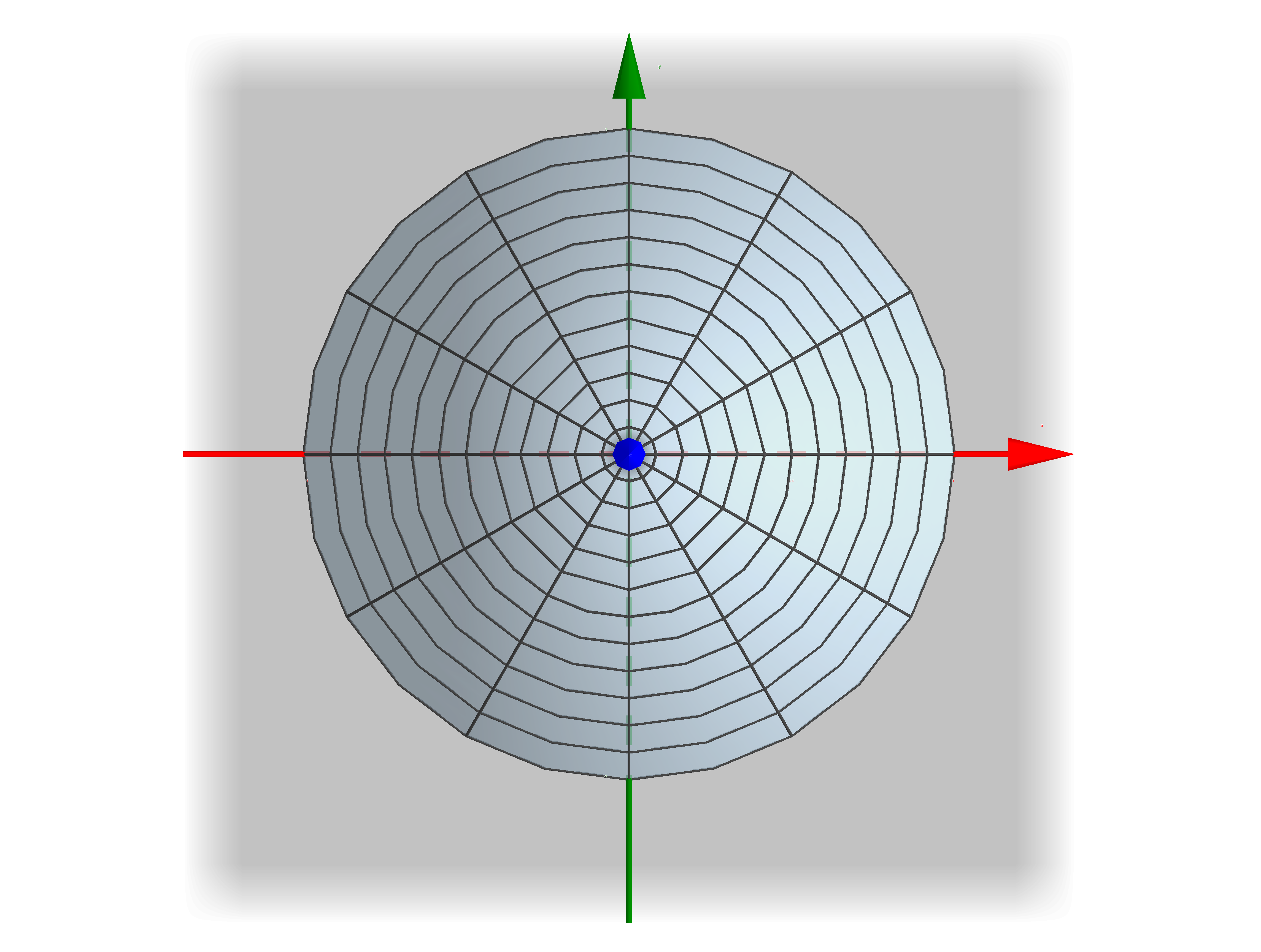
|
Let's begin with the parametrisation of $S$. Consider $x$ and $y$ as parameters, so \[ \r(x,y) = x~\i + y~\j + \left(1-x^2-y^2\right)~\k \] $x$ and $y$ are bounded by intersection curve of \[ z=1-x^2-y^2\quad \text{and} \quad z=0. \] That is, $x^2+y^2=1$. So the domain for $x$ and $y$ is given by $x^2+y^2\leq 1$. |
41.1.1 Application: find the surface area of the paraboloid $z=1-x^2-y^2$ for $z\geq 0 $

|
Thus \[ \r_x = \i-2x~\k, \quad \r_y = \j-2y~\k, \] and $ \r_x\times\r_y = \left| \begin{array}{ccc} \i & \j & \k\\ 1 & 0 & -2x \\ 0 & 1 & -2 y \end{array} \right| $ $= 2x~\i + 2y ~\j + \k$. Since $||\r_x\times\r_y||=\sqrt{4x^2+4y^2+1},$ then \[ dS = ||\r_x\times\r_y|| ~dx~dy = \sqrt{4x^2+4y^2+1}~dx~dy. \] |
41.1.1 Application: find the surface area of the paraboloid $z=1-x^2-y^2$ for $z\geq 0 $

|
|
41.2 More on calculating surface integrals, applications
Let $f(x,y,z)$ be a scalar function in $\R^3.$ We can define the surface integral of $f$ over a smooth parametric surface $S$ in $\R^3$ as \[ \iint_S f(x,y,z)~dS = \iint_D f\left(\r(u,v)\right)\norm{\r_u\times \r_v}~du~dv. \]
Surface integrals and double integrals have similar applications. Indeed, a double integral is merely a special case of a surface integral where the surface lies entirely in the $xy$-plane.
41.2 More on calculating surface integrals, applications
For example, if a thin sheet has the shape of a surface $S$ and the mass density at the point $(x, y, z)$ is $\rho(x, y, z),$ then the mass of the sheet is given by a surface integral: \[ \text{mass of sheet} = \iint_D \rho (x,y,z)~dS. \]
41.2 More on calculating surface integrals, applications
Another application is in calculating the average value of a function over a surface. Let $S$ be a smooth surface in $\R^3.$ Then the average value of the function $f(x,y,z)$ over that surface is given by \[ \text{average value over surface} = \frac{1}{\text{area of } S}\iint_S f (x,y,z)~dS. \]
41.2 More on calculating surface integrals, applications
If the surface $S$ is a closed surface, it is convention to write
 to represent the surface integral.
to represent the surface integral.
41.2 More on calculating surface integrals, applications
If $S$ is a finite union of smooth surfaces $S_1, S_2,\ldots, S_n$ that intersect only at their boundaries, then \[ \begin{multline*} \iint_S f (x,y,z)~dS = \\ \iint_{S_1} f (x,y,z)~dS + \iint_{S_2} f (x,y,z)~dS + \cdots + \iint_{S_n} f (x,y,z)~dS. \end{multline*} \] Closed surfaces are often unions of smooth surfaces as demonstrated in the following example.
41.2.1 The function $T (x, y, z) = x^2 + y^2 + z^2 + 4 $
gives the temperature at any point $(x, y, z)$ on the surface of a solid hemisphere of radius 1 centred at the origin, defined for $z\geq 0$. Find the average temperature over the surface
41.2.1 The function $T (x, y, z) = x^2 + y^2 + z^2 + 4 $
gives the temperature at any point $(x, y, z)$ on the surface of a solid hemisphere of radius 1 centred at the origin, defined for $z\geq 0$. Find the average temperature over the surface
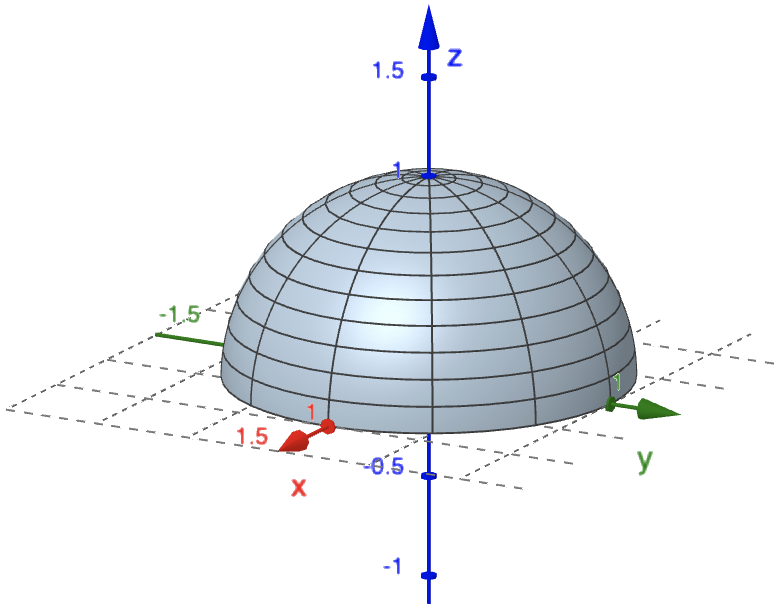
|
Here we have that
$
\displaystyle \text{Average temp.} = \frac{\displaystyle\iint_S
T~dS}{\text{area of }S}\qquad \qquad \qquad \qquad
$ where $S_1$ is the base and $S_2$ is the top. |
41.2.1 The function $T (x, y, z) = x^2 + y^2 + z^2 + 4 $
gives the temperature at any point $(x, y, z)$ on the surface of a solid hemisphere of radius 1 centred at the origin, defined for $z\geq 0$. Find the average temperature over the surface

|
For $S_1$: Here we have a disk in the $xy$-plane of radius $1$. Then the parametrisation is \[ \r(x,y) = x~\i+y~\j+0~\k\quad (x^2+y^2\leq 1). \] Then $\r_x = \i$, $\r_y = \j$ and \[ dS = \norm{\r_x\times \r_y }~dx~dy= dx~dy. \] So $\displaystyle \iint_{S_1} T~dS = \iint_{S_1} \left( x^2+y^2+z^2+4\right)dx~dy$ or $\displaystyle \iint_{S_1} T~dS = \iint_{S_1} \left( x^2+y^2+(0)^2+4\right)dx~dy$ That is $\displaystyle \iint_{S_1} T~dS = \iint_\limits{x^2+y^2\leq 1} \left( x^2+y^2+4\right)dx~dy$. |
41.2.1 The function $T (x, y, z) = x^2 + y^2 + z^2 + 4 $
gives the temperature at any point $(x, y, z)$ on the surface of a solid hemisphere of radius 1 centred at the origin, defined for $z\geq 0$. Find the average temperature over the surface

|
For $S_1$: Using polar coordinates \[ x = r\cos\theta , \quad y = r \sin \theta \] with $0\leq r \leq 1$ and $0\leq \theta \leq 2 \pi$, we have
|
41.2.1 The function $T (x, y, z) = x^2 + y^2 + z^2 + 4 $
gives the temperature at any point $(x, y, z)$ on the surface of a solid hemisphere of radius 1 centred at the origin, defined for $z\geq 0$. Find the average temperature over the surface

|
For $S_1$: Using polar coordinates \[ x = r\cos\theta , \quad y = r \sin \theta \] with $0\leq r \leq 1$ and $0\leq \theta \leq 2 \pi$, we have
|
41.2.1 The function $T (x, y, z) = x^2 + y^2 + z^2 + 4 $
gives the temperature at any point $(x, y, z)$ on the surface of a solid hemisphere of radius 1 centred at the origin, defined for $z\geq 0$. Find the average temperature over the surface

|
For $S_2$: Now we have a half sphere of radius 1. Then the parametrisation is \[ \r(\theta,\phi ) = \cos\theta \sin \phi~\i+ \sin\theta \sin \phi ~\j+\cos \phi~\k \] where $0\leq \theta \leq 2 \pi$ and $0 \leq \phi \leq \pi/2$. Then $ \quad \r_{\theta} = -\sin\theta \sin \phi~\i+ \cos\theta \cos \phi ~\j+0~\k $ $ \quad \r_{\phi} = \cos\theta \cos \phi~\i+ \sin\theta \cos \phi ~\j- \sin \phi~\k $ |
41.2.1 The function $T (x, y, z) = x^2 + y^2 + z^2 + 4 $
gives the temperature at any point $(x, y, z)$ on the surface of a solid hemisphere of radius 1 centred at the origin, defined for $z\geq 0$. Find the average temperature over the surface
For $S_2$: Then
$\qquad
\r_{\theta}\times\r_{\phi} =
\left|
\begin{array}{ccc}
\i & \j & \k\\
-\sin\theta \sin \phi & \cos\theta\sin \phi & 0 \\
\cos \theta \cos \phi & \sin \theta \cos \phi & -\sin \phi
\end{array}
\right|
$
$\qquad\quad= -\cos \theta \sin ^2 \phi ~\i - \sin \theta \sin ^2
\phi ~\j - \left(\sin ^2 \theta
+\cos^2 \theta\right)\sin \phi \cos \phi ~\k$.
$\Rightarrow \norm{\r_{\theta}\times\r_{\phi} } =\sqrt{ \cos^2 \theta \sin ^4 \phi + \sin^2 \theta \sin ^4 \phi + \sin^2 \phi \cos^2 \phi }$
41.2.1 The function $T (x, y, z) = x^2 + y^2 + z^2 + 4 $
gives the temperature at any point $(x, y, z)$ on the surface of a solid hemisphere of radius 1 centred at the origin, defined for $z\geq 0$. Find the average temperature over the surface

|
So \[ \iint_{S_2} T~dS = \iint_{S_2}\left(x^2+y^2+z^2+4\right)dS \] |
41.2.1 The function $T (x, y, z) = x^2 + y^2 + z^2 + 4 $
gives the temperature at any point $(x, y, z)$ on the surface of a solid hemisphere of radius 1 centred at the origin, defined for $z\geq 0$. Find the average temperature over the surface

|
|
41.2.1 The function $T (x, y, z) = x^2 + y^2 + z^2 + 4 $
gives the temperature at any point $(x, y, z)$ on the surface of a solid hemisphere of radius 1 centred at the origin, defined for $z\geq 0$. Find the average temperature over the surface

|
Therefore
$
\displaystyle \text{Average temp.} = \frac{\displaystyle\iint_{S_1} T~dS +
\iint_{S_2} T~dS
}{\displaystyle\iint_{S_1} ~dS + \iint_{S_2} ~dS }$
|